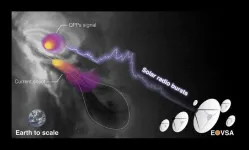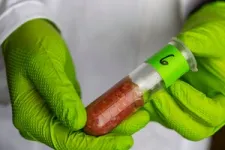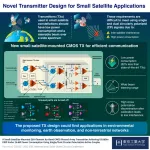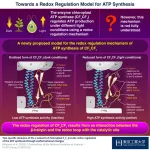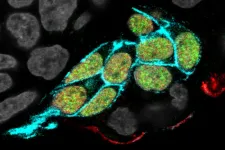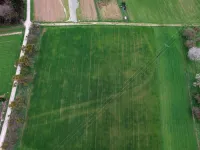(Press-News.org) A solar radio burst with a signal pattern, akin to that of a heartbeat, has been pinpointed in the Sun’s atmosphere, according to a new study.
In findings published in the journal Nature Communications, an international team of researchers has reported uncovering the source location of a radio signal coming from within a C-class solar flare more than 5,000 kilometers above the Sun’s surface.
Researchers say the study’s findings could help scientists better understand the physical processes behind the energy release of solar flares — the solar system’s most powerful explosions.
“The discovery is unexpected,” said Sijie Yu, the study’s corresponding author and astronomer affiliated with NJIT’s Center for Solar-Terrestrial Research. “This beating pattern is important for understanding how energy is released and is dissipated in the Sun’s atmosphere during these incredibly powerful explosions on the Sun. However, the origin of these repetitive patterns, also called quasi-periodic pulsations, has long been a mystery and a source of debate among solar physicists.”
Solar radio bursts are intense bursts of radio waves from the Sun, which are often associated with solar flares and have been known to feature signals with repeating patterns.
The team was able to uncover the source of these pattern signals after studying microwave observations of a solar flare event on July 13, 2017, captured by NJIT’s radio telescope called the Expanded Owens Valley Solar Array (EOVSA), which is located at Owens Valley Radio Observatory (OVRO), near Big Pine, Calif.
EOVSA routinely observes the Sun in a wide range of microwave frequencies over 1 to 18 gigahertz (GHz) and is sensitive to radio radiation emitted by high-energy electrons in the Sun’s atmosphere, which are energized in solar flares.
From EOVSA’s observations of the flare, the team revealed radio bursts featuring a signal pattern repeating every 10-20 seconds, “like a heartbeat”, according to study leading author Yuankun Kou, a Ph.D. student at Nanjing University (NJU).
The team identified a strong quasi-periodic pulsation (QPP) signal at the base of the electric current sheet stretching more than 25,000 kilometers through the eruption’s core flaring region where opposing magnetic field lines approach each other, break and reconnect, generating intense energy powering the flare.
But surprisingly, Kou says they discovered a second heartbeat in the flare.
“The repeating patterns are not uncommon for solar radio bursts,” Kou said. “But interestingly, there is a secondary source we did not expect located along the stretched current sheet that pulses in a similar fashion as the main QPP source.”
“The signals likely originate from quasi-repetitive magnetic reconnections at the flare current sheet,” added Yu. “This is the first time a quasi-periodic radio signal located at the reconnection region has been detected. This detection can help us to determine which of the two sources caused the other one.”
Using the unique microwave imaging capabilities of EOVSA, the team was able to measure the energy spectrum of electrons at the two radio sources in this event.
“EOVSA’s spectral imaging gave us new spatially and temporally resolved diagnostics of the flare’s nonthermal electrons. … We found the distribution of high-energy electrons in the main QPP source vary in phase with that of the secondary QPP source in the electronic current sheet,” said Bin Chen, associate professor of physics at NJIT and co-author of the paper. “This is a strong indication that the two QPPs sources are closely related.”
Continuing their investigation, the team members combined 2.5D numerical modeling of the solar flare, led by the other corresponding author of the paper and professor of astronomy Xin Cheng at NJU, with observations of soft X-ray emission from the solar flares observed by NOAA’s GOES satellite, which measures the soft X-ray fluxes from the Sun’s atmosphere in two different energy bands.
“We wanted to know how the periodicity occurs in the current sheet”, said Cheng. “What is the physical process driving the periodicity and how is it related to the formation of the QPPs?”
The team’s analysis showed there are magnetic islands, or bubble-like structures that form in the current sheet, quasi-periodically moving toward the flaring region.
“The appearance of magnetic islands within the long-stretched current sheet plays a key role in tweaking the energy release rate during this eruption,” explained Cheng. “Such a quasi-periodic energy release process leads to a repeating production of high-energy electrons, manifesting as QPPs in the microwave and soft X-ray wavelengths.”
Ultimately, Yu says the study’s findings cast fresh light on an important phenomenon underlying the reconnection process that drives these explosive events.
“We’ve finally pinpointed the origin of QPPs in solar flares as a result of periodic reconnection in the flare current sheet. … This study prompts a reexamination of the interpretations of previously reported QPP events and their implications on solar flares.”
…
Additional co-authors of the paper include NJU researchers Yulei Wang and Mingde Ding, as well as Eduard P. Kontar at the University of Glasgow. This research was supported by grants from the National Science Foundation.
END
Researchers discover mysterious source of 'heartbeat-like' radio bursts in a solar fare
2023-02-21
ELSE PRESS RELEASES FROM THIS DATE:
Three talented researchers recognized as endowed chairs
2023-02-21
Huntsman Cancer Institute at the University of Utah (The U) is pleased to congratulate three of our newest endowed chairs. A chair appointment recognizes excellence, while providing academic distinction and funding for future research. Alana Welm, PhD, received a five-year extension in her current role as Ralph E. and Willia T. Main Presidential Endowed Chair in Cancer Research, Aik Choon Tan, PhD, was named the Jon and Karen Huntsman Presidential Professor in Cancer Research, and Brad Cairns, PhD, was named ...
New transmitter design for small satellite constellations improves signal transmission
2023-02-21
Today, there are many emerging applications for small satellite constellations, ranging from space-borne networks to environmental monitoring. However, small satellites have special needs when it comes to transmitter (TX) technology. For one, they have stringent limitations on power consumption as they draw energy from solar panels and cannot easily dissipate generated heat. Moreover, small satellites need to communicate with fast-moving targets that can be over a thousand kilometers away. Thus, they require efficient and precise beam steering capabilities to direct most of the transmitted power ...
Improving the performance of satellites in low Earth orbit
2023-02-21
A database updated in 2022 reported around 4,852 active satellites orbiting the earth. These satellites serve many different purposes in space, from GPS and weather tracking to military reconnaissance and early warning systems. Given the wide array of uses for satellites, especially in low Earth orbit (LEO), researchers are constantly trying to develop better ones. In this regard, small satellites have a lot of potential. They can reduce launch costs and increase the number of satellites in orbit, providing a better network with wider coverage. ...
Researchers uncover how photosynthetic organisms regulate and synthesize ATP
2023-02-21
ATP, the compound essential for the functioning of photosynthetic organisms such as plants, algae, and cyanobacteria, is produced by an enzyme called “chloroplast ATP synthase” (CFoCF1). To control ATP production under varying light conditions, the enzyme uses a redox regulatory mechanism that modifies the ATP synthesis activity in response to changes in the redox state of cysteine (Cys) residues, which exist as dithiols under reducing (light) conditions, but forms a disulfide bond under oxidizing (dark) conditions. ...
Sheep can benefit urban lawn landscapes and people
2023-02-21
Bicycles whirr by, students rush to class, staff and faculty are grabbing lunch or coffee on the go — and sheep graze the grassy knolls among the traffic, bleating every now and then. The grazing is their job.
The 25 wooly sheep who seasonally — for the past two years — leave their University of California, Davis, barns to nibble on lawns at various central campus locations, are doing much more than mowing, fertilizing and improving the ecosystem. The sheep also are improving people’s mental health.
The sheep — four breeds of Suffolk, Hampshire, Southdown and Dorset — first took on this role in 2021, when COVID-19 ...
UCLA Health tip sheet: Pesticides & Parkinson’s symptoms; Gender-affirming hormones tied to mental health for transgender youth; Body composition, not BMI, may signal risk for cardiovascular disease
2023-02-21
UCLA Health Tip Sheet Feb. 21, 2023
Below is a brief roundup of news and story ideas from the experts at UCLA Health. For more information on these stories or for help on other stories, please contact us at uclahealthnews@mednet.ucla.edu.
Body composition, not BMI, may signal risk for cardiovascular disease Body mass index has long been a measure of a person’s risk of developing cardiovascular disease, but body composition and its role in the disease have not been well studied. In a new study, ...
Better tools needed to determine ancient life on Mars
2023-02-21
ITHACA, N.Y. – Current state-of-the-art instrumentation being sent to Mars to collect and analyze evidence of life might not be sensitive enough to make accurate assessments, according to a research team co-led by a Cornell University astronomer.
In a paper published in Nature Communications, visiting planetary scientist Alberto Fairén, and an international team of researchers, claim that ancient organic material in Martian rocks could be difficult, if not impossible, to detect with current instruments and techniques.
Fairén – also a research professor at the Center ...
Rewiring blood cells to give rise to precursors of sperm
2023-02-21
Different cell types—say, heart, liver, blood, and sperm cells—possess characteristics that help them carry out their unique jobs in the body. In general, those characteristics are hard-wired. Without intervention, a heart cell won’t spontaneously transform into a liver cell.
Yet researchers from the University of Pennsylvania School of Veterinary Medicine, working with collaborators from the University of Texas at San Antonio and Texas Biomedical Research Institute, have prompted marmoset blood cells to acquire the flexibility of stem cells. Then they directed those stem cells to take on the characteristics of sperm ...
Hidden from the Romans: 200 tons of silver on the shores of the river Lahn
2023-02-21
When Prof. Markus Scholz, who teaches archaeology and the history of Roman provinces at Goethe University, returned to Bad Ems toward the end of the excavation work, he was astonished: After all, all the photos sent by his colleague Frederic Auth showed but a few pieces of wood. Not surprisingly, Scholz was ill-prepared for what he saw next: a wooden defense construction consisting of sharpened wooden stakes, designed to prevent the enemy’s approach. The martial-looking structure was intended to deter enemies from attacking the camp. Such installations – ...
Air pollution speeds bone loss from osteoporosis: Large study
2023-02-21
Elevated levels of air pollutants are associated with bone damage among postmenopausal women, according to new research led by scientists at Columbia University Mailman School of Public Health. The effects were most evident on the lumbar spine, with nitrous oxides twice as damaging to the area than seen with normal aging.
The research findings appear in the peer-reviewed journal eClinicalMedicine, part of The Lancet Discovery Science suite of open-access journals.
Previous studies on ...
